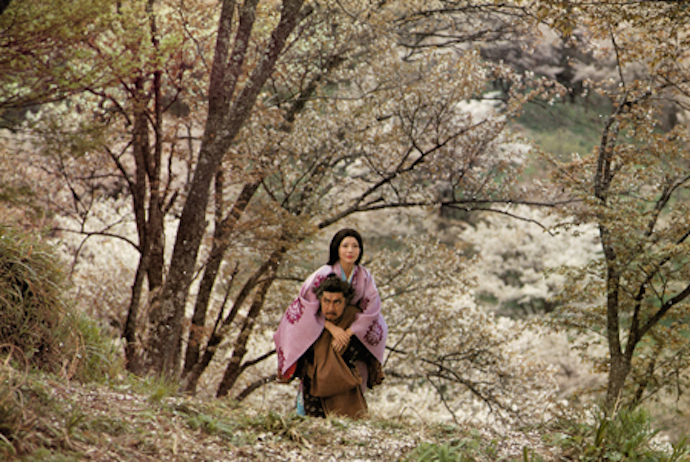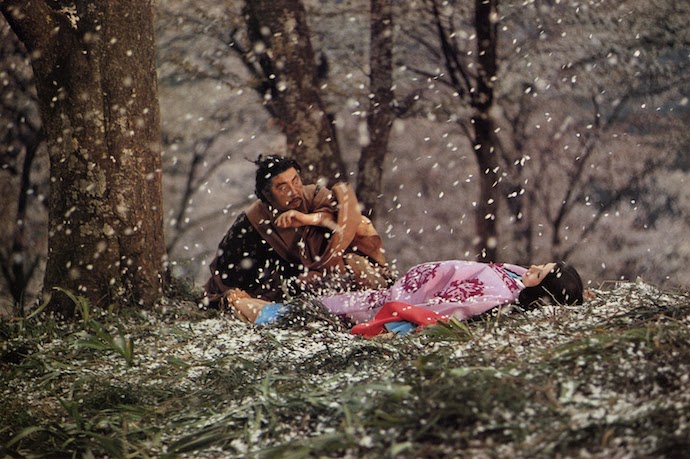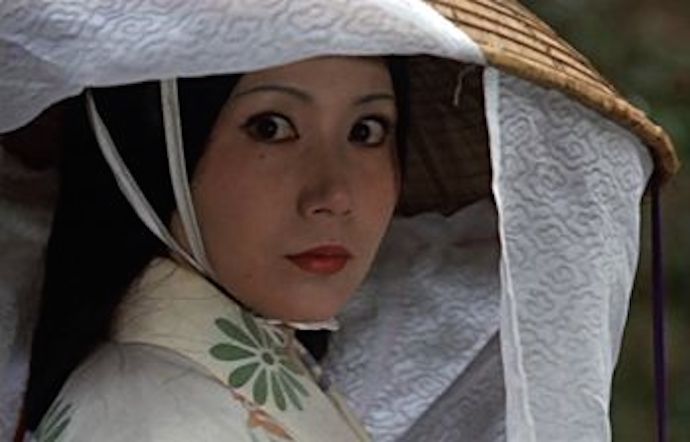Masahiro Shinoda and his film Under the Blossoming Cherry Trees (1975)
04.02.15

“When cherry trees blossom, people have parties. They sit under the trees with food and beverages. ‘Oh, how beautiful.’ That’s all nonsense…before that the trees were feared.”
When he directed Under the Blossoming Cherry Trees, Shinoda had already established himself years’ prior as a notable member of Japanese New Wave cinema. Like many of his contemporaries, he began his career in the 1950s at Shōchiku Studios as an assistant director, working under such greats as Yasujirō Ozu (Tokyo Story, Tokyo Chorus, Floating Weeds). Shōchiku began in the late 1800s as a kabuki production company, later expanding to include Noh and Bunraku (a form of traditional puppet theatre). The company began making films in the 1920s and still operates today, amassing a reputation for taking chances on producing films that were genre bending, experimental and not always financially successful; it gave many of Japan’s greatest directors a place to start. Shinoda eventually left Shōchiku in 1965 to form his own production company, but the studio’s history and beginnings as a theatre production company played a large role in influencing Shinoda and the aesthetics of many of his contemporaries.
Shinoda himself studied theatre along with film, and the former has remained an ever-present part of much of his work. I hesitate to say “influence” because Shinoda, like many of his contemporaries, I think, was inspired by the idea of creating a type of live, immortalized theatre on screen. There are beautifully designed sets, paintings, props, the grating sound of the biwa (a traditional Japanese lute) accompanied by bits and pieces of narration or chanting. In Double Suicide (1969), Shinoda even went so far as to occasionally portray the characters as bunraku puppets.
In Under the Blossoming Cherry Trees, we are treated to one of Masahiro Shinoda’s most terrifyingly beautiful works. Based on a shorty story by Ango Sakaguchi, the film tells the tale of a poor Mountain Man who kills his seven wives (six to be precise; he leaves one alive to be a servant) to please an alluring woman he has captured. As the film progresses, the Mountain Man goes to unimaginable lengths to please his New Wife, who is never satisfied.
Another notable aspect of Under the Blossoming Cherry Trees is composer Toru Takemitsu’s score for the film. The atonality and sparseness of the music coupled with the colorful imagery on screen enhances our experience⎯eerie chanting, rhythmic motifs and quick flute trills add a welcome accompaniment to an already rich visual tapestry.

“You don’t hesitate to kill people but you’re afraid of flowers?”
As he carries her on his back through the mountains, his new wife asks, “Can’t you walk any faster? I thought you were a man.” This sets a familiar tone for the rest of the film. Mountain Man suffers endless humiliation at the hands of his shrewish New Wife, and this is one of the things I love about Shinoda’s work from this period: hauntingly beautiful females degrade and humiliate their male counterparts. These men suffer, never seeming to be able to live up to expectations. In Under the Blossoming Cherry Trees, the New Wife is more reminiscent of a twisted femme fatale–her beauty and sex appeal make her powerful–she is smart, manipulative and gets what she wants. But, by the end, through their own machinations, both male and female suffer greatly and each is offered a similar fate, whether it be death, loneliness, or suicide.
Shinoda doesn’t shy away from exploring some of the more hideous aspects of Japanese life. He questions cultural and historic norms, the context in which these beliefs exist, as well as the human problems these beliefs can create. He touches on how entire groups of people can become marginalized or shamed out of society, forced into a life that’s a miserable existence, out on the fringes of society scraping at its leavings to stay alive. In an in interview with UC Berkley film critic Harry Kreisler, Shinoda says that the “main characters in [his] films are always on the losing side, or the vanquished side.” He then continues, saying that the types of monsters humanity creates are much worse than any we could imagine.
In Under the Blossoming Cherry Trees, we have the main characters themselves, who are monsters, and we also have a group of beggars who appear later in the film, and the Pardoned Ones, criminals who have confessed their crimes to escape death and have been forced into a life of servitude as bounty hunters. I think it’s also interesting to note that in this film, the main characters have no names–there is not a single scene in the entire movie where they address each other formally.

“Well-trodden paths formed far from the cherry trees. No one walked through the cherry trees then. It was quiet.”
The film opens with the sounds of traffic and the shouts of people celebrating. Before we skip back to the Edo period, we are treated to a glimpse of how people live during the present day; suited businessmen drinking and playing drums, people having picnics as the blossoms fall around them. In many of Shinoda’s films (like many directors he has a ton and I make no claim to have seen them all) there is always this tension, a push and pull between the modern and the ancient; we have cars, trains, cigarettes, guns and buses that appear periodically in places that otherwise feel timeless.
I don’t understand Japanese and probably never will, so unfortunately it’s necessary for me to watch this film with subtitles, and although I can be sure it’s not how Shinoda intended it to be watched, I find it very enjoyable. At certain moments in the film, the frames pair beautifully with the subtitles on screen, offering us an endless amount of meme-like moments. I don’t think that I’m exaggerating when I say that each frame on the screen is a poem in itself, and paired with the words/subtitles, it offers us another avenue to question our identity as viewers, aware of both the subtext we’re expected to create from each frame due to the subtitles and the one we actually create. Again it was probably not Shinoda’s intention but it’s nonetheless an added bonus.
I’m always careful while watching a film with subtitles because I’m conscious of how meanings can get skewed, or how things can be lost or distorted due to the language barrier. However, much of Shinoda’s themes are universal. He critiques morals and beliefs common to any culture: shame, domestic life, adultery, traditions, religious belief, forbidden love, growing up destitute, murder, the list goes on.
“take me back to the capitol city and bring me everything I desire…use your strength to please me.”
In Under the Blossoming Cherry Trees there are vast, beautiful landscapes at the beginning and end of the film, in sharp contrast to the scenes of life in the capitol city, which is supposed to be Edo or modern-day Tokyo. Both the Mountain Man and the New Wife travel to the city seeking fortune and a more lavish life, but they quickly become bored with it and then the film really does evolve into a horror movie.
To cure her boredom, the New Wife orders the Mountain Man to bring her the heads of distinguished members of the capitol. Each day, he returns with a sac of heads for his wife, who arranges them and plays with them as if they were puppets. She asks for more hideous looking heads to complete her collection. She wants an audience. These heads are her court; she cherishes them. She speaks to them in her empty courtly rhetoric as they rot around the house. The Mountain Man begins to thirst for spring water and empty space; eventually, both agree to make the trek back to the mountains, taking the shortcut through the blossoming cherry trees. Without giving too much away, we can be sure that they each come to a sinister end, and in classic Shinoda fashion, we as viewers are left to wonder which parts of the story are true, or if the characters ever existed to begin with.

“It feels like fresh green leaves are shedding tears.”
Shinoda’s films are incredibly sad; Under the Blossoming Cherry Trees is no exception. As it progresses, the film makes it clear that no one will be allowed to have a happy ending. Shinoda exercises his talent of taking the viewer through a wide range of emotions. I’ve often found that after watching one of his films I’m exhausted–I usually feel like I’ve watched several films at once. Citing Orson Welles as an influence, Shinoda has said that films allow us to experience heightened emotions, ones we may not usually experience in everyday life; he also says it is much more interesting to look at evil than to look at good: “I think I continue making films because it is a way that I can investigate evil…evil gives us a great motive for doing things…unhappiness gives us a very fertile, rich ground for emotions and education emotions.”
Through playing with familiar archetypes, Shinoda allows us to witness these evils and explore their outcomes. This is a horror film, and it is classified as such, but the horror exists in the human aspects of this film, not in some vague apparition.
Under the Blossoming Cherry Trees is a way of investigating this evil; a human evil; an evil that oozes out of superstition and tradition; an evil of the ideas of what wealth and beauty may bring to those who choose to seek it at any cost.